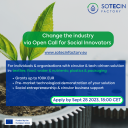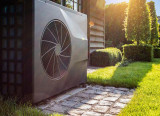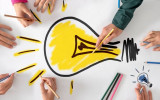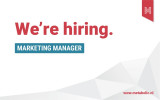Stay in the know on all smart updates of your favorite topics.
😀Resultaten - Is betrokkenheid van de gemeenschap de moeite waard? 😀

We hebben uiteenlopende en interessante reacties ontvangen van stedenbouwkundigen, architecten en gemeenten. Als u wilt weten wat andere professionals denken, vul dan deze enquête in met uw e-mailadres en wij delen de inzichten met u.
Bedankt! 😀
Follow Playground on LinkedIn
We've received varied and interesting responses from urban developers, architects, and municipalities. If you want to know what other professionals think, please fill out this survey with your email, and we will share the insights with you.
Thank you! 😀
When will robotaxi’s become commonplace? (8/8)

Until recently, optimists would say "in a few years." Nobody believes that anymore, except for Egon Musk. The number of - so far small - incidents involving robot taxis is increasing to such an extent that the cities where these taxis operate on a modest scale, San Francisco in particular, want to take action.
Europe vs USA
In any case, it will take a long time before robotaxis are commonplace in Europe. There are two major differences between the US and Europe when it comes to transportation policy.
In the US, each state can individually determine when autonomous vehicles can hit the road. In Europe, on the other hand, a General Safety Regulation has been in force since June 2022 that applies to all countries. This states, among other things, that a driver must maintain control of the vehicle at all times. Strict conditions apply to vehicles without a driver: separate lanes, short routes on traffic-calmed parts of the public road and always with a 'safety driver' on board.
The second difference is that in the US 45% of all residents do not have public transport available. In Europe you can get almost anywhere by public transport, although the frequency is low in remote areas. Governments say they want to further increase accessibility by public transport, even if this is at the expense of car traffic. To this end, they want an integrated transport policy, a word that is virtually unknown in the US.
Integrated transport policy
In essence, integrated transport policy is the offering of a series of transport options that together result in (1) the most efficient, safe and convenient satisfaction of transport needs, (2) reduction of the need to travel over long distances (including via the '15- minutes city') and (3) minimal adverse effects on the environment and the quality of life, especially in the large cities. In other words, transport is part of policy aimed at improving the quality of the living environment.
Integrated transport policy assesses the role of vehicle automation in terms of their contribution to these objectives. A distinction can be made between the automation of passenger cars (SAE level 1-3) and driverless vehicles (SEA level 4-5).
Automation of passenger cars
Systems such as automatic lane changes, monitoring distance and speed, and monitoring the behavior of other road users are seen as contributing to road safety. However, the driver always remains responsible and must therefore be able to take over steering at any time, even if the car does not emit a (disengagement) signal. Eyes on the road and hands on the wheel.
Driverless cars
'Hail-riding' will result in growth of traffic in cities because the number of car kilometers per user increases significantly, at the expense of walking, cycling, public transport and to a much lesser extent the use of private cars. Sofar, the number of people who switch from their own car to 'hail-riding' is minimal. The only way to reverse this trend is to impose heavy taxes on car kilometers in urban areas. On the other hand, the use of robot shuttles is beneficial in low-traffic areas and on routes from residential areas to a station. Shuttles are also an excellent way to reduce car use locally. For example, in the extensive Terhills resort in Genk, Belgium, where people leave their cars in the parking lot and transfer to autonomous shuttles that connect the various destinations on the site with high frequency.
A few months ago (April 2023), I read that Qbus in the Netherlands wants to experiment with 18-meter-long autonomous buses, for the time being accompanied by a 'safety driver'. Routes on bus lanes outside the busiest parts of the city are being considered. Autonomous metros and trains have been running in various cities, including London, for years. It is this incremental approach that we will need in the coming years instead of dreaming about getting into an autonomous car, where a made bed awaits us and we wakes us rested 1000 kilometers away. Instead of overcrowded roads with moving beds, we are better off with a comfortable and well-functioning European network of fast (sleeper) trains on a more modern rail infrastructure and efficient and convenient pre- and post-transport.
Automated cars; an uncertain future (7/8)

The photograph above is misleading. Reading a book instead of watching the road is not allowed in any country, unless the car is parked.
For more than a decade, car manufacturers have been working on technology to take over driver's actions. A Lot of money has been invested in this short period and many optimistic expectations have been raised, but no large-scale implementation of the higher SAE levels resulted so far. Commercial services with robotaxi’s are scarce and still experimental.
The changing tide
Especially in the period 2015 - 2018, the CEOs of the companies involved cheered about the prospects; soon after, sentiment changed. In November 2018, Waymo CEO John Krafcik said that the spread of autonomous cars is still decades away and that driving under poor circumstances and in overcrowded cities will always require a human driver. Volkswagen's CEO said fully self-driving cars "may never" hit public roads.
The companies involved are therefore increasingly concerned about the return on the $100 billion invested in the development of car automation until the end of 2021. The end of the development process is not yet in sight. Much has been achieved, but the last 20% of the journey to the fully autonomous car will require the most effort and much more investment. Current technology is difficult to perfect. “Creating self-driving robotaxi is harder than putting a man on the moon,” said Jim Farley, CEO of Ford, after terminating Argo, the joint venture with Volkswagen, after the company had invested $100 million in it.
The human brain can assess complex situations on the road much better than any machine. Artificial intelligence is much faster, but its accuracy and adaptability still leave much to be desired. Driverless cars struggle with unpredictability caused by children, pedestrians, cyclists, and other human-driven cars as well as with potholes, detours, worn markings, snow, rain, fog, darkness and so on. This is also the opinion of Gabriel Seiberth, CEO of the German computer company Accenture, and he advises the automotive industry to focus on what is possible. Carlo van de Weijer, director of Artificial Intelligence at TU Eindhoven, agrees: “There will not be a car that completely takes over all our tasks.”
Elon Musk, on the other hand, predicted that by 2020 all Tesla’s will have SEA level 5 thanks to the new Full Self Driving Chip. In 2023 we know that its performance is indeed impressive. Tesla may therefore be the first car to be accredited at SAE level 3. That is not yet SAE level 5. The question is whether Elon Musk minds that much!
The priorities of the automotive industry
For established automotive companies, the priority is to sell as many cars as possible and not to make a driver redundant. The main objective is therefore to achieve SAE levels 2 and possibly 3. The built-in functions such as automatic lane changing, keeping distance, and passing will contribute to the safe use of cars, if drivers learn to use them properly. Research shows that drivers are willing to pay an average of around $2,500 for these amenities. That is different from the $15,000 that the beta version of Tesla's Full Self Driving system costs.
The automotive industry is in a phase of adjusting expectations, temporizing investments, downsizing involved business units, and looking for partnerships. GM and Honda are collaborating on battery development; BMW, Volkswagen and Daimler are in talks to share R&D efforts for autonomous vehicles; and Ford and VW have stopped developing an autonomous car and are working together on more realistic ambitions.
Safety issues at SAE level 3
But even with a focus on SAE level 3, the problems do not go away. The biggest safety problem may well lie at this level. Elon Musk has suggested for years that Tesla's autopilot would allow drivers to read a book or watch a movie. All they must do is stay behind the wheel. They must be able to take control of the car if the automatic system indicates that it can no longer handle the situation. Studies in test environments show that in this case the reaction time of drivers is far too long to prevent disaster. An eye on the road and a hand on the wheel is still mandatory everywhere in the world, except in few paces for cars accredited at SEA level 4 under specified conditions.
The assumption is that the operating system is so accurate that it indicates in time that it considers the situation too complex. But there are still many doubts as to whether these systems themselves are sufficiently capable of properly assessing the situation on the road at all times. Recent research from King's College London showed that pedestrian detection systems are 20% more accurate when dealing with white adults than when dealing with children and 7.5% more accurate when dealing with white people compared to people with dark skin.
In the next post I will go into more detail about the legislation and what the future may bring.
You still can download for free my newest e-book '25 building blocks to create better streets, neighborhoods and cities' by following the link below
First driverless taxis on the road (6/8)

Since mid-2022, Cruise and Waymo have been allowed to offer a ride-hailing service without a safety driver in a quiet part of San Francisco from 11pm to 6am. The permit has now been extended to the entire city throughout the day. The company has 400 cars and Waymo 250. So far, it has not been an unqualified success.
A turbulent start
In a hilarious incident, an empty taxi was pulled over by police; it stopped properly, but kept going after a few seconds, leaving the officers wondering if they should give chase. The National Highway Traffic Safety Administration is investigating this incident, as well as several others involving Cruise taxis stalling at intersections, and the Fire Department reports 60 incidents involving autonomous taxis.
Pending further investigation, both companies are only allowed to operate half of their fleet. In addition to the fire department and public transport companies, trade unions are also opposed to the growth of autonomous taxis. California's governor has rejected the objections, fearing that BigTech will swap the state for more car-friendly ones. It is expected that autonomous taxis will gradually enter all major US cities, at a rate just below that of Uber and Lyft.
Cruise has already hooked another big fish: In the not-too-distant future, the company will be allowed to operate autonomous taxis in parts of Dubai.
The number of autonomous taxi services in the world can still be counted on one hand. Baidu has been offering ride-hailing services in Wuhan since December 2022, and robot taxis have been operating in parts of Shenzen since then.
Singapore was the first city in the world to have several autonomous taxis operating on a very small scale. These were developed by nuTonomy, an MIT spin-off, but the service is still in an experimental phase. Another company, Mobileye, also plans to start operating in Singapore this year.
The same company announced in 2022 that it would launch a service in Germany in 2023 in partnership with car rental company Sixt 6, but nothing more has been heard. A survey by JD Power found that almost two-thirds of Germans do not trust 'self-driving cars'. But that opinion could change quickly if safety is proven and the benefits become clear.
What is it like to drive a robotaxi?
Currently, the group of robotaxi users is still small, mainly because the range is limited in space and time. The first customers are early adopters who want to experience the ride.
Curious readers: Here you can drive a Tesla equipped with the new beta 1.4 self-driving system, and here you can board a robotaxi in Shenzhen.
The robotaxis work by hailing: You use an app to say where you are and where you want to go, and the computer makes sure the nearest taxi picks you up. Meanwhile, you can adjust the temperature in the car and tune in to your favourite radio station.
Inside the car, passengers will find tablets with information about the journey. They remind passengers to close all doors and fasten their seatbelts. Passengers can communicate with remote support staff at the touch of a button. TV cameras allow passengers to watch. Passengers can end the journey at any time by pressing a button. If a passenger forgets to close the door, the vehicle will do it for them.
The price of a ride in a robotaxi is just below the price of a ride with Uber or Lyft. The price level is strongly influenced by the current high purchase price of a robotaxi, which is about $175,000 more than a regular taxi. Research shows that people are willing to give up their own cars if robotaxis are available on demand and the rides cost significantly less than a regular taxi. But then the road is open for a huge increase in car journeys, CO2 emissions and the cannibalisation of public transport, which I previously called the horror scenario.
Roboshuttles
In some cities, such as Detroit, Austin, Stockholm, Tallinn and Berlin, as well as Amsterdam and Rotterdam, minibuses operate without a driver, but usually with a safety officer on board. They are small vehicles with a maximum speed of 25 km/h, which operate in the traffic lane or on traffic-calmed streets and follow a fixed route. They are usually part of pilot projects exploring the possibilities of this mode of transport as a means of pre- and post-transport.
Free download
Recently, I published a new e-book with 25 advices for improving the quality of our living environment. Follow the link below to download it for free.
5. Driving without a driver has a price

In an autonomous car from SAE level 4, perception equipment – the eyes and ears – and software take over human brain functions. This requires accurate maps, laser, radar, lidar and cameras. The lidar, which means 'detect light and range', works in conjunction with the car's cameras. This system pulses laser waves to map the distance to objects day and night, up to up to 100 meters with an accuracy of a few centimeters. The price of all this equipment is between €150,000 and €200,000. The lidar is a high-cost item, although this system is becoming increasingly cheaper due to industrial production. Together, these tools build a four-dimensional image of the environment, and all functions of the moving car are controlled using stored software and communications in the cloud.
Google/Waymo
Google's X-lab began developing an autonomous car in 2009. In 2016, the company had already completed more than 1.5 million test kilometers and spent $1.1 billion on the development of an autonomous car. The company previously used a self-developed model ('the firefly', see photo). The company then deployed converted Chrysler Pacifica Hybrids, and these will be exchanged for fully electric Jaguar I-Pace cars.
In 2016, Google's parent company Alphabet parlayed autonomous car developments into a new company called Waymo (derived from "a new way of mobility").
General motorcycles/cruise
Cruise was founded in 2013 with the intention of developing a self-driving car. In 2016, General Moters acquired the company for an amount of $500 million. To date, the company has completed 700,000 test miles in San Francisco's urban environment with no fatalities.
Uber
In 2016, Uber began working with Volvo to develop an autonomous car that could serve as a taxi. The company had acquired software manufacturer Otto for a net $600 million. The company predicted that there will be 75,000 self-driving cars on the road by 2019. That became zero. During the test phase, the company experienced several accidents, including one with a fatal outcome. In addition, Waymo became a target of data theft, a case that was decided in Waymo's favor by the court. Uber therefore had to pay damages of €250 million (in shares). This led to the departure of Uber founder Travis Kalanick. His successor, Dara Khosrowshahi, has put the development of an autonomous car on the back burner. It was recently announced that Uber has signed a contract with Waymo to use this company's autonomous cars in the future.
Tesla
Until recently, the use of lidar was not possible due to the high costs for car manufacturers that opt for accreditation at SAE level 3. Tesla therefore equipped its cars exclusively with radar, cameras and computer vision. The latter means that all driving Teslas transmit camera images of traffic and the way in which motorists react to 'the cloud'. The company has been developing these images with artificial intelligence for years. It prides itself on the fact that its cars have rules of conduct for every conceivable traffic situation.
The development of the Tesla was accompanied by high expectations but also by many accidents, some of which were fatal. Last year, Tesla made available a beta version of the FSD ("Full Self Driving") software package for a price of $15,000. However, the company had to recall as many as 362,000 cars under the authority of the Traffic Safety Administration because this package was encouraging illegal driving. It looks like that these issues have been resolved and some experts have suggested that Tesla will be able to qualify for accreditation at least at SEA Level 3. This still has to happen.
Ford and Volkswagen
These companies threw in the towel in 2022 and unplugged Argo, a company that was supposed to develop an autonomous car to provide SAE level 4 taxi services. Instead, both companies announced focusing on the SAE levels 2 and 3, like most auto makers.
According to analysts at AlixPartners, the industry has invested $100 billion in developing car automation by 2023, in addition to $250 billion in development of electric cars. I will discus the profitability of these investments later.
Minecraft Almere Pampus Challenge: pushing the boundaries to build the city of the future

In today's dynamic landscape, the key to success lies in collaboration. The Green Innovation Hub firmly believe in the power of partnerships between companies, government and educational institutions to drive innovation, growth and positive change. In a world where technology connects us in unique ways, the Minecraft Almere Pampus Challenge exemplified the power of communities coming together to achieve remarkable feats.
It's inspiring to witness the incredible work of our young talents. They are the architects of the future and they're currently building virtual cities where companies can find their next digital solutions. Whether you represent a company, government department, or educational institution, we invite you to connect and explore how we can collaborate to make a meaningful impact on our shared goals.
1. Fresh Perspectives: young talent brings fresh and innovative perspectives to the table. They're unafraid to challenge the status quo and reimagine how things can be done.
2. Cutting-Edge Tech: these virtual cities are powered by the latest technologies from Microsoft and Iamprogrez. Companies can tap into this tech-savvy generation to incorporate cutting-edge solutions into their operations.
3. Collaboration Opportunities: collaborating with these digital pioneers can lead to mutually beneficial partnerships. Your company can gain a competitive edge while offering mentorship and growth opportunities to the next generation.
Find the Green Innovation Hub (NL Pavilion) at the Smart City Expo World Congres in Barcelona, and let's meet each other. Together, we'll keep pushing the boundaries of what's possible in the Minecraft universe and to build the house – or even the city of the future. Also stay tuned for upcoming advantures, events and challenges on our channels.
Watch the video: https://youtu.be/4F7CFGfb2HE
Smart Energy Community - Elaad Testlab - Arnhem

Op 31 oktober organiseren FAN en TKI Urban Energy de tweede fysieke netwerkbijeenkomst van de Smart Energy Community, in het testlab van ElaadNL, Arnhem, met als onderwerp:
Domotica en Home Energy Management Systems in de praktijk
Eindgebruikers aan het woord
Hoe weerbarstig is de praktijk? Sommige eindgebruikers zijn zelf al aan de slag gegaan met domotica om hun energiegebruik slim aan te sturen. Wij laten drie van deze enthousiastelingen aan het woord: Jan Kerdel, Michiel Damoiseaux & Harm van den Brink. Wat zijn hun ervaringen? Waar liepen ze tegenaan?
Setting the scene: HEMS & Domotica
Jasmijn Kleij van TKI Urban Energy gaat in op de vraag of Domotica ook kansen op voor slim energiemanagement biedt, of dat het nu nog vooral een oplossing voor de enthousiaste knutselaars.
Praktische lessen uit Belgie
Giovanni Oorthuizen van Xemex zal een presentatie geven over de nieuwe wet- en regelgeving in België, hoe zij daarop inspelen met energiediensten, en hun ervaringen met eindgebruikers.
En verder
* Paneldiscussie over Domotica, energiemanagement en de rol van de eindgebruiker
* Speeddaten & netwerken
Aanmelden
https://www.aanmelder.nl/smartenergyday/subscribe
Volledige programma ochtendsessie:
https://www.aanmelder.nl/smartenergyday/wiki/924116/ochtendprogramma
Volledige programma middagsessie: 'Smart Energy Day 2.0', georganiseerd door TKI Urban Energy, Dutch Power, Connectr, RVO en ElaadNL
https://www.aanmelder.nl/smartenergyday/part_program
Free KNX Smart Energy IoT workshop at FLEXCON2023 September 20 - 14.00 – 16.30 hours – max 8 developers.

KNX and FLEXCON2023 are hosting an in-depth KNX IoT development workshop. Are you a developer who wants to build Smart Energy applications? Bring your RPi’s and other Linux devices and come to Les Brigittines in Brussels on September 20th ! Connect heatpumps, EV's, Solar systems, smart meters, sensors, batteries etc to the smartgrid
In this workshop, you will get to understand the KNX IoT development approach. You will get your hands om a state-of-the-art test bench, equipped with a virtual KNX installation featuring actuators with load control and real-time current detection, providing instant power consumption insights.
The workshop is free of charge. We have only 8 spots available, so apply now! For more information and subscription to the KNX IoT workshop on September 20th:
https://survey.alchemer.com/s3/7460981/FLEXCON-2023-KNX-IoT-Workshop
For information on the #FLEXCON2023 event:
https://flexcon.energy
Call for Social Innovators: Join the SoTecIn Factory for Circular Economy Solutions in Agrifood, Textiles, Plastics & Packaging Industries!

Exciting opportunity for all social innovators! SoTecIn Factory calls individuals and organizations in the agrifood, textiles, plastics & packaging industries with tech solutions based on circular economy & social innovation!
SoTecIn supports mission-driven circular ventures in leading the industry towards a low-carbon and circular economy transition through sustainable solutions, utilising higher R circular strategies. We provide up to 100k EUR in funding, help you to get to a pre-market demonstration, and provide capacity-building and mentorship.
Is this interesting for you or for someone in your network? Make sure to apply or share this with them!
Apply here: https://lnkd.in/eJnjfpDS
Find out more about the program: https://lnkd.in/exTueWti
Metabolic CEO, Eva Gladek, was nominated for the Big Little Talk at Circularity 23!

Creating a sustainable planet for future generations is essential, and understanding our impacts on nature is a critical step toward achieving this goal.
Unfortunately, measuring impact on nature is complicated and requires specific expertise. We need to combine impact data with geospatial analysis to really see where the different activities along companies’ value chains are taking place, and how those impact nature and biodiversity locally.
By voting for Eva's Big Little Talk, you will Metabolic showcase the importance of nature assessments on the big stage at Circularity 23.
It takes only 1 minute, vote for our video in the link below.
#circularity23 #LinkByMetabolic #natureassessment
Large amount of protocols in the heat pump industry hinders easy implementation of energy management systems

Unfortunately, there is no single way for remotely controlling new heat pumps yet, nor is there a trend in that direction, according to the 'Flexmonitor Heat pumps' report. This hampers the possibilities of easily and quickly deploying heatpumps for a reliable electricity supply and creates unnecessary costs and complexity to use energy management systems.
Fortunately, the vast majority of heat pumps do support smart energy services. FAN and TKI Urban Energy therefore aim to use one standard for all energy management applications so that 80% of the market volume uses the same open energy management standard by the end of 2024.
We really need to work towards standardisation for the large-scale deployment of energy management for heat pumps, is the appeal of the FAN foundation.
Want to learn more? Read more about it and download the flexmonitor report here:
Beep for Help, direct hulp aan huis

Beep for help ontzorgt alle Amsterdammers die wel wat hulp thuis kunnen gebruiken.
De oplossing voor ouderen die prettig thuis willen blijven wonen, overbelaste mantelzorgers of mensen die meer tijd willen voor ontspanning.
Makkelijk boeken van hulp bij boodschappen, koken, schoonmaken, tuinieren, huisdieren of gezelschap. Zonder wachtlijsten. Simpel en snel. Wij zijn er trots op een Amsterdamse startup te zijn. Wij werken graag samen met andere organisaties om elkaar te versterken. Neem contact op voor de mogelijkheden.
The Public Stack: a Model to Incorporate Public Values in Technology

Public administrators, public tech developers, and public service providers face the same challenge: How to develop and use technology in accordance with public values like openness, fairness, and inclusivity? The question is urgent as we continue to rely upon proprietary technology that is developed within a surveillance capitalist context and is incompatible with the goals and missions of our democratic institutions. This problem has been a driving force behind the development of the public stack, a conceptual model developed by Waag through ACROSS and other projects, which roots technical development in public values.
The idea behind the public stack is simple: There are unseen layers behind the technology we use, including hardware, software, design processes, and business models. All of these layers affect the relationship between people and technology – as consumers, subjects, or (as the public stack model advocates) citizens and human beings in a democratic society. The public stack challenges developers, funders, and other stakeholders to develop technology based on shared public values by utilising participatory design processes and open technology. The goal is to position people and the planet as democratic agents; and as more equal stakeholders in deciding how technology is developed and implemented.
ACROSS is a Horizon2020 European project that develops open source resources to protect digital identity and personal data across European borders. In this context, Waag is developing the public stack model into a service design approach – a resource to help others reflect upon and improve the extent to which their own ‘stack’ is reflective of public values. In late 2022, Waag developed a method using the public stack as a lens to prompt reflection amongst developers. A more extensive public stack reflection process is now underway in ACROSS; resources to guide other developers through this same process will be made available later in 2023.
The public stack is a useful model for anyone involved in technology, whether as a developer, funder, active, or even passive user. In the case of ACROSS, its adoption helped project partners to implement decentralised privacy-by-design technology based on values like privacy and user control. The model lends itself to be applied just as well in other use cases:
- Municipalities can use the public stack to maintain democratic approaches to technology development and adoption in cities.
- Developers of both public and private tech can use the public stack to reflect on which values are embedded in their technology.
- Researchers can use the public stack as a way to ethically assess technology.
- Policymakers can use the public stack as a way to understand, communicate, and shape the context in which technology development and implementation occurs.
Are you interested in using the public stack in your own project, initiative, or development process? We’d love to hear about it. Let us know more by emailing us at publicstack@waag.org.
New Smart Energy Community Event scheduled on October 11: in-person meetup.

Join our speed date and engage with 3 great speakers at the first in-person Smart Energy Community meetup on October 11th!
Topics Smart Energy Community October 11:
Home Energy Management Systems in practice
Now that we are installing more and more heat pumps and EV chargers in homes, there is more and more need for energy management. How does this work? How to deal with cyber security and what role do protocols play? ElaadNL developed its own showcase house where this is put into practice. Arjan Wargers of Flexiblepower Alliance Network & ElaadNL discusses the lessons learned.
Power pitch ATEPS: Energy and storage
ATEPS develops, builds and supplies systems based on batteries that store energy. Jos Theuns (ATEPS) explains how they make storage of sustainable energy accessible, safe and attractive through smarter management of electrical energy. Due to the modular construction of ATEPS systems, they are suitable for both small and larger customers.
Power pitch withthegrid: Teleport
How do you connect PV, wind, battery, EV chargers and heat pumps without losing your mind in all protocols and without cloud lock-in? Paul Mignot (Withthegrid) discusses their new innovation Teleport. This gives customers maximum insights and control over their assets in minutes.
Speed dating, networking & visit demonstration house
In the second half, connecting with other professionals is central. During these speed dating sessions, you will get to know fellow innovators, share project ideas and explore opportunities for collaboration. There will be ample opportunity for discussion after the meeting. At the same time, you can take a tour of ElaadNL's new demonstration home for smart energy services, where various smart devices are optimised for home energy management.
Free KNX Smart Energy & IoT development workshop on June 28 – max 15 developers

KNX and FLEXCON2022 are hosting a free KNX Smart Energy & IoT development workshop on June 28, for 15 developers max.
Are you a developer who wants to build Smart Energy applications? Bring your RPi’s and other Linux devices and come to Pakhuis de Zwijger in Amsterdam on June 28th !
In this 'mini-hackathon’, you will get to understand the KNX IoT development approach. You will utilize a free client-development solution to interact with the KNX installation to build Energy Management solutions for a cleaner, smarter world. Connect heatpumps, EV's, batteries and solar panels to the smart grid!
The workshop is free of charge. We have only 15 spots available, so apply now! For more information and subscription to the KNX IoT workshop on June 28, check the link:
5 belangrijke inzichten uit het Responsible Drones Report

De inzet van drones in steden is volop in ontwikkeling en kan in de nabije toekomst helpen bij het oplossen van allerlei vraagstukken. Maar naast kansen brengt de technologie ook risico’s met zich mee, zoals schending van privacy en dreigingen op het gebied van veiligheid en cybersecurity. Wat is er nodig om drones verantwoord toe te passen?
Het Responsible Sensing Lab, Amsterdam Drone Lab en Amsterdam Smart City sloegen de handen ineen om deze vraag te beantwoorden middels een reeks kennis- en designsessies in het Responsible Drones project. Het Lab brengt nu een rapport uit vol inzichten en adviezen voor verantwoord dronegebruik. De vijf inzichten die centraal staan:
De gemeente Amsterdam onderzoekt op basis van de 4 vastgestelde rollen (gebruiker, regelgever, faciliteerder en beschermheer) de kansen van zinvolle drone toepassingen in de openbare ruimte.
Voor verantwoord droneverkeer moet de proportionaliteit van de toepassing getoetst worden. Vandaag de dag zijn er nog geen spelregels rondom de maatschappelijke proportionaliteit van drones.
Bewoners en maatschappelijke organisaties moeten bij ontwikkelingen rondom drones sterker worden aangehaakt én aangehaakt blijven. Momenteel vinden projecten rondom de toepassing van drones voornamelijk plaats in de vorm van publiek-private samenwerkingen waarin marktpartijen sterk vertegenwoordigd zijn.
Toekomstscenario’s met drones lijken voor veel mensen nog ver weg en er is over het algemeen weinig kennis over dit onderwerp. Door de complexiteit is de dialoog met burgers over drones een uitdaging.
Drones roepen snel argwaan op bij burgers. Heldere communicatie over drones verhoogt de publieke acceptatie en maakt tegenspraak door burgers mogelijk.
Benieuwd naar de toelichting en bijbehorende adviezen van deze vijf inzichten? Download een korte of lange versie van het rapport op: https://responsiblesensinglab.org/nl/projecten/responsible-drones#report.
Responsible Drones is een samenwerking tussen het Responsible Sensing Lab, Amsterdam Drone Lab, Marineterrein Amsterdam en Amsterdam Smart City.
Afbeelding: © Dutch Drone Delta, Antea Group
The Creative Industry Program's

The Creative Industry Program's main objective is to enhance creative skills in all segments of the industry, stimulating the emergence of new business opportunities, in addition to offering business representation, professional education and technology for various creative sectors.
The Program works in the development of industries through forums, and through the articulation of a network that includes universities, development agencies, government and private initiative, and creative networks. Internationally, the Creative Industry Program is a reference for countries and international organizations.
Based on the needs and opportunities identified in the economic context, the Program works to develop innovative skills, in order to create a favorable environment for business.
The Creative Industry Program seeks to develop the potential of creative entrepreneurship networks, in addition to promoting distribution through communication channels.
to know more
Send us an email to motivaco@gmail.com
Geef laptops aan de Cyberbank

Amsterdam krijgt de eerste Cyberbank van Nederland; een soort voedselbank voor laptops en digitale ondersteuning. 💻♻️
Heb jij een laptop of heeft jouw organisatie laptops die de Cyberbank een tweede leven kan geven? Vraag je werkgever oude laptops te doneren aan de Cyberbank en deel deze oproep binnen je netwerk!
Hoe meer laptops, hoe meer mensen er blij gemaakt kunnen worden.
#decyberbankzoektlaptops
Hoe het werkt?
➡️ Organisaties en particulieren doneren hun oude laptops.
➡️ Jongeren met een afstand tot de arbeidsmarkt knappen ze op.
➡️ Mensen met een Stadspas met groene stip kunnen tegen statiegeld van €20 euro aanspraak maken op een laptop. De eerste opgeknapte laptops worden begin 2022 verdeeld.
Informatie over de inzameling van gebruikte laptops en de eisen vind je op https://decyberbank.nl/
Marineterrein Amsterdam joins the Amsterdam Smart City network (in Dutch)

Het is nu officieel! Marineterrein Amsterdam en Amsterdam Smart City worden partners en gaan de samenwerking verder intensiveren. Het doel: kennis delen en samen aan de slag om tot oplossingen voor stedelijke vraagstukken te komen.
Amsterdam Smart City (ASC) zet zich vanaf het Marineterrein al jaren in voor open innovatie door als platform partijen en organisaties aan elkaar te verbinden. Kennis delen en samen aan de slag staan hierbij centraal.
Samenwerking
Een voorbeeld van zo’n samenwerking op het Marineterrein is het Responsible Sensing Lab, waarbij een aantal ASC-partners in de openbare ruimte experimenteren met verantwoorde detectiesystemen om bijvoorbeeld geluidsoverlast of drukte in kaart te brengen. Verschillende partijen brengen bij deze experimenten hun expertise bij elkaar om samen tot oplossingen te komen. De lessen die we daaruit leren zijn waardevol voor heel veel Smart City projecten.
Breder delen
‘Het Marineterrein bestaat uit een levendige community die zich bezighoudt met het oplossen van allerlei stedelijke vraagstukken’, zegt directeur van Bureau Marineterrein Liesbeth Jansen. ‘Er is op het terrein veel kennis aanwezig over nieuwe manieren van leren, wonen en werken, en door ons aan te sluiten bij het ASC-netwerk kan die kennis nu breder gedeeld worden. En andersom kijken we uit naar interessante samenwerkingen tussen het ASC-netwerk en Marineterrein Amsterdam Living Lab die onze community verder kunnen helpen.’
Leren in real life
Directeur van ASC Leonie van den Beuken ziet met de samenwerking veel kansen om nieuwe, innovatieve oplossingen in real life te testen. ‘Een van onze kernwaarden is leren door te doen. Het Marineterrein biedt een prachtig testgebied voor oplossingen die we in de praktijk willen uitproberen. We zijn daarom één van de partners in het Marineterrein Living Lab. Daarnaast staan wij beiden voor open innovatie ten behoeve van een leefbare stad. Aangezien het Marineterrein onze thuisbasis is, is het logisch om onze netwerken en ambities nog meer aan elkaar te verbinden.’
Job advert: Marketing Manager

Metabolic is looking for a Marketing Manager!
They will help in increasing the reach and impact of Metabolic's work by putting the right content in front of the right people in collaboration with the digital communications manager.
If you are keen to contribute to a sustainable economy, check out this opportunity. Or if you know someone who fits the bill, kindly share with them.
Stay up to date
Get notified about new updates, opportunities or events that match your interests.

